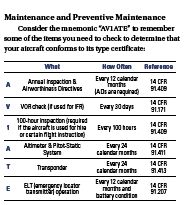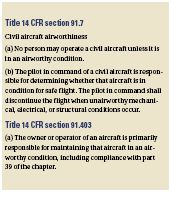Airworthy or Not?
Barry Ballenger
Reprinted with permission from FAA Aviation News
Aviation lore is replete with tales of foolishly fearless flyers whose idea of determining airworthiness was little more than a cursory kick-the-tires-and-light-the-fires “inspection.” Fortunately, few pilots today succumb to the lure of the lore. Such derring-do was the undoing of many early aviators, so preflight protocols and aviators’ attitudes have both come a long way. In fact, one of the first things the modern student pilot learns is that the pilot in command (PIC) must conduct a thorough preflight inspection and establish that the aircraft to be flown is “airworthy.”
What Is “Airworthy?”
Anyone with a sense of self-preservation and regard for passenger safety can agree that it’s a good idea to establish airworthiness, but many pilots falter a bit when it comes to understanding what that really means. Airworthy means the aircraft conforms to its type design and is in a condition for safe operation according to section 3.5 of Title 14 Code of Federal Regulations (14 CFR). There is also a definition on the Standard Airworthiness Certificate (FAA Form 8100-2) displayed in your aircraft. It certifies that: “as of the date of issuance, the aircraft to which issued has been inspected and found to conform to the type certificate therefore, to be in condition for safe operation, and has been shown to meet the requirements of the applicable comprehensive and detailed airworthiness code as provided in Annex 8 to the Convention on International Civil Aviation, except as noted herein.”
As you see, the Standard Airworthiness Certificate stipulates that an aircraft can be deemed airworthy when it meets two conditions. First, it must conform to its type certificate and any approved changes to the type design. Second, it must be in a condition for safe operation.
For the most part, the preflight inspection you learned to do on your first flying lesson is the mechanism for meeting the second requirement. The PIC checks for obvious defects which can include worn tires, damage to structure, improper fluid levels, missing fasteners, and inoperative systems. In this connection, the PIC needs to be familiar with the requirements of 14 CFR section 91.213, which sets out the procedure for handling inoperative equipment. In a nutshell: Any item that the regulations require for the type of operation (e.g., day/night, VFR, or IFR) must be in working order for the aircraft to be deemed airworthy and in a condition for safe operation. If any other item is inoperative, 14 CFR section 91.213(d) states that it must be removed or de-activated, placarded, and recorded.
Conforming to Type Certificate
The “Terms and Conditions” section of the Standard Airworthiness Certificate offers important guidance on some of the items you must consider in determining whether an aircraft conforms to its type design. Let’s review the wording:
Unless sooner surrendered, suspended, revoked, or a termination date is otherwise established by the Administrator, this airworthiness certificate is effective as long as the maintenance, preventive maintenance, and alterations are performed in accordance with parts 21, 43, and 91 of the federal aviation regulations, as appropriate, and the aircraft is registered in the United States.
From this wording, you can infer that part of ensuring conformance with the aircraft’s type design is making sure that required maintenance, preventive maintenance, and repairs are performed, and that these actions are accomplished in accordance with applicable regulations.

Repairs and Alterations
Two other actions that can affect conformance with the type certificate are repairs and alterations to the aircraft.
Repairs: From FAA’s standpoint, a “repair” is an action taken to return an aircraft to its current type design, and therefore to an airworthy status. Typical repairs include replacing defective parts, such as a vacuum pump, or making approved sheet metal repairs, such as repairing damage from a bird or deer strike.
Alterations: In FAA parlance, an “alteration” is any action that changes or modifies the original type design. For example, an alteration might involve installation of an engine or propeller not included in the type design.
When a repair or an alteration affects the aircraft’s weight and balance, structural strength, performance, power plant operation, or flight characteristics or operations, it is deemed to be a “major” repair or alteration.
Now for the Paperwork…
Here is the basic rule: Regulations require anyone who performs required maintenance (including inspections), preventive maintenance, repairs, or alterations to document the work. The PIC is responsible for ensuring repairs have been appropriately documented before attempting to operate the aircraft.
So, what are you looking for? You should be able to locate the entries for required maintenance, inspections, and preventive maintenance in the aircraft’s maintenance records. For anything that qualifies as a major repair or major alteration, however, the PIC needs to check the aircraft maintenance records as well as for completion of FAA Form 337 (“Major Repair and Alteration”).
Form 337 gives FAA, as well as aircraft owners and operators, a record of major repairs and major alterations to the aircraft, along with details and necessary approvals. FAA does not expect the pilot to perform a technical review of the repair or alteration, but the PIC is responsible for ensuring that the required documentation is complete and that the aircraft has been approved for return to service.
Cautionary Notes
As you see from this discussion, a lot goes into the PIC’s determination of airworthiness. Here are a few things to keep in mind:
- Just as it states, the Standard Airworthiness Certificate is effective only if the aircraft conforms to its type certificate and is in a condition for safe operation at the time you plan to fly. Even if all required maintenance, inspections, and repairs or alterations have been performed and documented, the aircraft is not airworthy if the PIC finds that an item needed for day VFR flight is inoperative. By the same token, the PIC may find all equipment in working order, but if any of the required maintenance, inspections, repairs, and alterations has not been performed or appropriately documented, the aircraft is not airworthy.
- The PIC must realize that any kind of maintenance signoff is a “snapshot” that reflects a specific time. The person performing the work is not liable for future airworthiness. The signed entry only denotes proper performance of the work performed. It is the responsibility of the PIC to establish that the aircraft is airworthy on any given day.
This is very important: If you, as PIC, have any concerns about the condition of an aircraft, don’t go flying until you have a properly certificated mechanic or repair facility determine if the aircraft is safe for flight and perform/document any necessary repairs. Finally, although maintenance personnel approve the aircraft for return to service, it is the PIC who actually returns the aircraft to service by flying it. As PIC, you are the final decision maker when it comes to determining if an aircraft is airworthy.
Barry Ballenger is an aerospace engineer at the FAA Small Airplane Directorate in Kansas City, Missouri. He also holds an A&P with Inspection Authorization and is a private pilot.
|